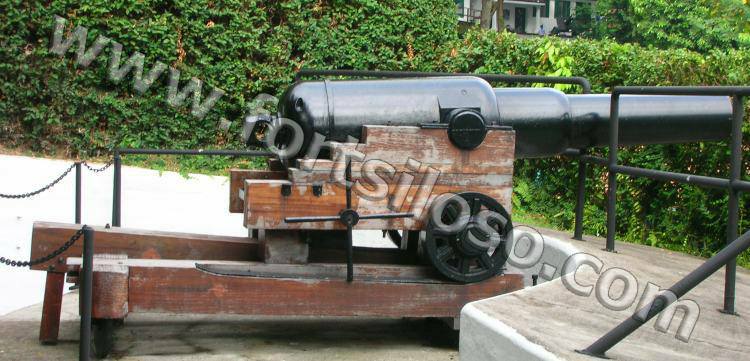Fort Siloso: 12 Pounder QF Gun of 12cwt


Mark III 64 Pounder RML Gun at Mount Palmer, Singapore
Three patterns of 64 Pounder RML (Rifled Muzzle Loading) Guns were produced at the Royal Arsenal Woolwich and the Elswick Works in Newcastle upon Tyne. The 64 Pounders were first put into service with the Royal Navy in 1864. They were used as broadside or pivot guns.
The RML 64-Pounder 64 Cwt was a rifled muzzle loading cannon which weighed 64 cwt (3251 kg). It fired a projectile weighing approximately 64 lbs (29 kg). The weight of the projectile varied on the type, common or shrapnel shell usually. The gun was made with a calibre of 6·3 inches (160mm) in order to make use of 32 Pounder smoothbore ammunition in an emergency situation.
The RML 64 Pounder Guns mounted in Singapore were Mark IIIs. There were two at Mount Palmer, two at Fort Teregah, two at Fort Blakang Mati East (later renamed as Fort Connaught), and two at Fort Siloso.
The guns at Fort Siloso were located overlooking the sea behind the Casemates. They were emplaced ‘en-barbette’, which means that they were on a flat platform behind a parapet. The guns would have been mounted on either a Carriage No.8 with Traversing Platform No.8, or a Carriage No.9 with Traversing Platform No.9. Both Carriages/Platforms being rather similar. It is likely that the guns in Singapore were on the Mark 8 Carriage/Platform combination.
The barrel is of of four sections; A toughened mild steel ‘A’ Tube with an inner diameter of 6·3 inches, The wrought iron ‘B’ Tube was shrunk onto the muzzle end of the ‘A’ Tube, The Breech Coil, made of coils of wrought iron was shrunk on the rear of the ‘A’ Tube, overlapping the ‘B’ Tube a little, finally the wrought Iron Cascable screw. The Trunnions for mounting the gun on its carriage were shrunk onto the Breech Coil.
The gun had three rifling grooves with a twist of 1 turn in 40 calibres (252 inches/6·4 metres). The gun was sighted on target by means of Side or centred sights of the tangent type.

Firing a Mark III 64 Pounder of 64 Cwt at Fort Lytton, Brisbane, Australia
Photo Courtesy of Fort Lytton Historic Military Precinct
Ammunition
Shells
The guns would have fired either Common or Shrapnel Shell. Common Shell weighed 64 lbs 11 oz (29.34 kg), including a bursting charge of 7 lb 2 oz (3.23 kg). Shrapnel Shell weighed 67 lb 7 oz (30.6 kg), and contained 234 mixed metal bullets. A 9 oz (0.26 kg) bursting charge was used with this shell. Common Shell was used against shipping, and Shrapnel would have been used against troops in boats. The shells had studs inserted into the side to engage in the rifling.
Propellant Charges
Propellant charges consisted of 10 lb (4.5 kg) of R.L.G. Powder Mark I. This weight constituted a full charge. The powder would be filled into either serge or silk bags, which were checked for correct size. Rifle Large Grain Powder is gun powder with grains small enough to pass through a sieve with four square meshes to the inch, and large enough to be held by 8 meshes to the inch.
The propellant charge would be loaded first, and then shell. Both are rammed to the breech together. The charge was set of by a friction tube inserted in the hole at the rear of the barrel.
The gun had a muzzle velocity of 1390 feet per second (420 metres p/s), giving a range of 5,000 yards (4,572 metres).
Gun Crew
The gun crew would normally consist of eight men:-
The Gun Commander
No.1 The Gun Layer, controlling aiming and firing.
No.2 Handling swabbing the gun barrel between shots.
No.3 Handspike and hauling down tackle.
No.4 Helping No. 2, operating the truck lever and elevating the gun.
No.5 Truck lever and assisting the No.7.
No.6 Handling cartridge cases.
No.7 Handling fuses, shells and running back the gun.
If need be, the gun could be operated with a team of four men.

An incorrectly mounted 64 Pounder on display at Fort Siloso











